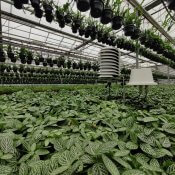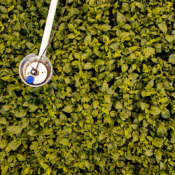A conversation with: crop advisor Peter van Os
The work of crop advisors or consultants is often an underexposed subject in horticulture. Especially now, this branch of sport cannot be envied. The usual visits to greenhouses take place partly in a different form and going abroad is not possible at the moment. To discuss the situation of advisers in more detail, we spoke to Peter van Os. VAN OS research is regarded within its circles as the source of information for Phalaenopsis and provides cultivation advice and research for pot orchids.
Synergy with the grower
Van Os is clear about the added value of consultants: “I look at crops and cultivation processes with different eyes because I visit different companies. Though it’s not the case that I ‘pollinate my knowledge’. The grower always decides what insights he keeps to himself and shares with others, which I think is no more than normal. In that light, the 30MHz platform is an excellent example of how the grower is in control. One entrepreneur shares more than the other. I also see that with excursion groups. For example, within the cut flower industry growers share more info than pot plant growers do.”
“I work with my wife Tettie and our specialty is quickly discovering how the plant is performing. We are building long-term relationships with growers, in which I indicate the improvements that are needed to promote growth and blossoming. Together we look at the climate computer data, graphs with climate data, nutritional data and quality information. And we test certain institutions, for example, how cold damage could have occurred in that one corner of the greenhouse. With the COVID-19 situation, this process is more difficult. I also speak with companies via digital means such as Skype and WhatsApp, but I notice that I would like to have more information at my disposal. I have access to certain online data sources, but more data could be shared. Again, the grower determines what is available, but to some solutions are not being considered.”

Commitment makes a difference and Van Os works according a carefully set up process. “I look at how the plant advances, and discuss with the grower what settings they could change with regard to the climate and nutrition supply, or how it’s possible that there are too many single branch plants. It’s a matter of checking all kinds of variables until the problem is known; too warm, too light, etc.” Van Os notices that growers in general, COVID-19 or not, are very busy anyway and therefore regularly look over data or simply do not record any. “Climate computers are recording more and more data, and are therefore slowing down. A grower then thinks: this is taking too long and is less inclined to perform deeper analysis. Capturing manual data is also not always accurate, like for example the pH and EC, which are not measured or written down.”
International differences
There are undoubtedly international differences between growers. “Various growers find it difficult to indicate what is going well and what is not going well via online channels. They are not used to that, so there’s still a kind of digital threshold. What do you want to improve? is a difficult question for them. But digitisation, in general, is an issue. Especially now that I cannot visit growers abroad, I have to rely on photos and videos. You can often zoom in on photos and you will get a nice picture of what kind of bugs or plagues plants are hosting, for example. But actually, you want all that media in a central spot, next to the climate data, so you can explain what is going on there. There are all kinds of data up for grabs, but they still need to be visualised nicely. Crop walks will always remain a part of the job, but I can work more efficiently if I can delve into the large amounts of information at home prior to my visits. A data platform would provide the necessary structure. This is a precursor of how the advice will be given in five or ten year from now. It will be really different then. Consultants will probably proactively advise growers how they can best organise their data too.
Opportunities
Van Os also sees opportunities for growers who have multiple locations at home and abroad. “Orchid growers often have multiple locations and could share much more data with each other. This should happen more. Colleagues sharing data and insights within their own company. That is not the case now because there is often a cultivation manager per location who likes to design it in his/her own way. Companies are getting bigger due to growth or mergers. It is then more difficult to oversee and a challenge to display all data in a handy way for the management team.

Growing Degree Units
VAN OS research looks a lot at the nutritional application, various climate data from climate computers and sensors. The analysis is done according to the most common tools. “I often look at graphs and individual numbers, so that is not so exciting. What I really see is a need for is Growing Degree Units; temperature hours or temperature days. Now with this virus, it is important to delay cultivation until the market picks up again. But from an economic point of view, timing has always been important. It is about selling your trade at the right time, such as Mother’s Day, and growing degree days can help growers with this. Still, I often see that estimating when the plants are suitable to put for sale is often a guessing game. While the plant itself has long been sold through fixed agreements, it makes more sense that you keep track of this not only on the basis of previous experience but also on the basis of data, paying attention to leaf temperature and light hours. Knowing when to accelerate or brake is key.


30MHz is typing… Our extended support team is ready to chat!
At 30MHz we think it’s important that our users can use our platform in an optimal way. At times you may have questions and you would like some help from our support team. Email and our support page filled with helpful articles were your go to’s. But we thought it was time for something extra… ...Read more
New 30MHz connect casing: How we protect your tech
To make sure your dataflow is fully protected, 30MHz introduces a new connect casing: waterproof, dust proof and even resistant to hits. This special shield will last longer and ensure a reliable dataflow from the connected sensor. What does that full protection mean? That’s what we will explain in this article. Watertight: resistant to wetness ...Read more
Most popular sensors for your greenhouse
As a grower, you know that optimal crop development starts with precise monitoring of your cultivation environment. But how do you transform raw data into actionable insights for your crops? This is where our wireless sensors and the 30MHz platform come together. Our sensors measure essential variables such as VPD, dew point, moisture deficit, EC, ...Read more


